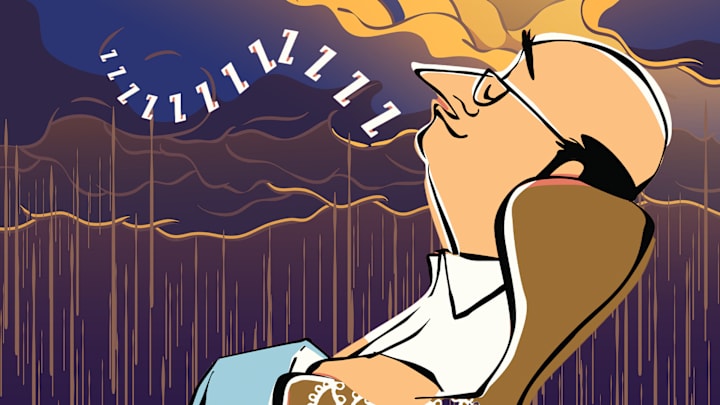Wet weather has made it’s way into plenty of songs over the years, from Gene Kelly’s “Singin’ in the Rain” to Prince’s “Purple Rain.” But while Kelly was singing and dancing his way through a rainstorm, an unnamed old man was napping during a downpour in the sing-songy nursery rhyme “It’s Raining, It’s Pouring.” The lyrics of this tune are likely lodged in your memory from childhood, but if not, here are the rhyming lines:
“It’s raining, it’s pouring,
The old man is snoring,
He bumped his head and went to bed,
And he couldn’t get up in the morning.”
Chances are you didn’t think too deeply about the meaning of this song as a kid, but as an adult, the last line about the man failing to wake up—i.e. presumably dying—darkly stands out. Read on to learn the surprising meaning behind this rainy rhyme.
As Right as Rain
The earliest written record of “It’s Raining, It’s Pouring” comes from Edwina Stanton Babcock’s short story “The Proving of the Prophet,” which was published in a November 1909 issue of The Outlook. This version of the rhyme simply consists of “It’s raining, it’s pouring, old men are snoring,” meaning that not only is it about old men plural (rather than a singular snorer), it also doesn’t include the head-hitting final two lines. In the story, the song is described as “unsatisfactory and lacking outline and climax,” but by singing the words repeatedly “with some new nasal intonation or with difference in key and measure, it held great charm.”
Just a few years later, the multiple men having a nap changed to just one dozing man in The Little Mother Goose (1914), but this version still didn’t include the last lines that are sung today. The detail of the man bumping his head and not getting up doesn’t appear in print until 1947 in Iona and Peter Opie’s I Saw Esau: Traditional Rhymes of Youth. They record the lines, “He got into bed / And bumped his head / And couldn’t get up in the morning.” Aside from bumping his head during or after getting into bed, rather than before, these lyrics are the same as the ones people are most familiar with.
Although it’s not widely known, there’s also an even longer version of the rhyme. In 1998, Dan and Kim Adlerman, writing together under the name Kin Eagle, published a short picture book that included six extra verses. Each verse starts with a weather-related jingle, such as “It’s cloudy, it’s breezy,” and “It’s snowing, it’s blowing,” and it’s revealed that the old man is called Willy and his wife is Cindy. These extra verses paint Willy as a generally clumsy man—he also “tripped and fell / in a big old well”—but he definitely doesn’t die after hitting his head.
As for the melody, “It’s Raining, It’s Pouring” is sung to the same tune as “Ring Around the Rosie” and “A-Tisket, A-Tasket.” The earliest audio recording is from 1939, with folklorist Herbert Halpert submitting two versions of the rhyme—one sung by himself and the other sung by Rosalind Rosenthal—to the Library of Congress.
When It Rains, It Pours
Although it isn’t known who added the lines about the man bumping his head and not getting up in the morning or what exactly they meant by that, there are two theories that could explain the old guy’s grim fate.
In Essential Neurosurgery, first published in 1991, neurosurgeon Professor Andrew Kaye writes that the ditty provides medical information about head injuries. “Deteriorating conscious state” is listed as “the most important neurological sign” of someone suffering from an extradural hematoma—essentially a blow to the head causing blood to collect between the brain and skull. Sleepiness is often an overlooked symptom and Kaye notes that the simple rhyme “is a classic description of an extradural hematoma leading to drowsiness and death.”
Another interpretation is it that the rhyme is actually about the dangers of drinking too much alcohol. In a now-viral TikTok video, @stupidlittlegenius explained her personal theory that “the old man liked a good drink and ‘it’s raining and pouring’ refers to the alcoholic drinks being poured very liberally.” It’s this drunken stupor that causes the man to hit his head and subsequently die. Although this theory is merely one person’s conjecture, the rhyme does have another link to alcohol. In 1938, Griesedieck Western Brewery Co. copyrighted a few rain-related phrases—likely for advertising purposes—including It’s raining! It’s pouring! and Swell weather … for ducks!
Read More About Nursery Rhymes:
